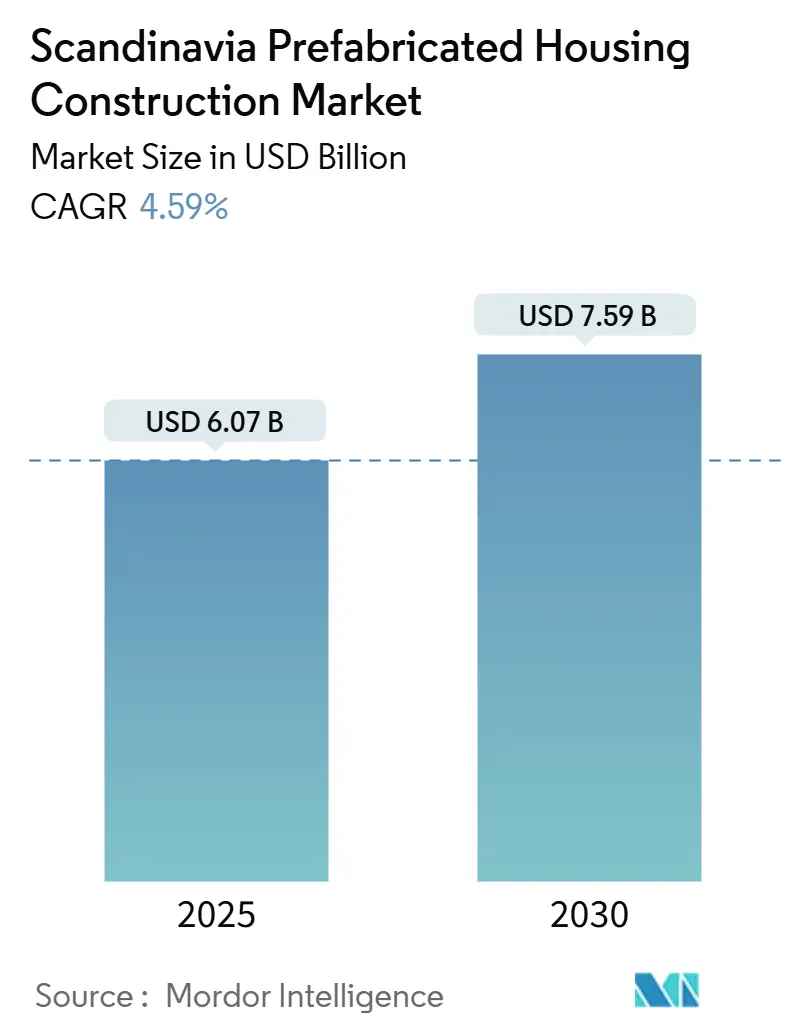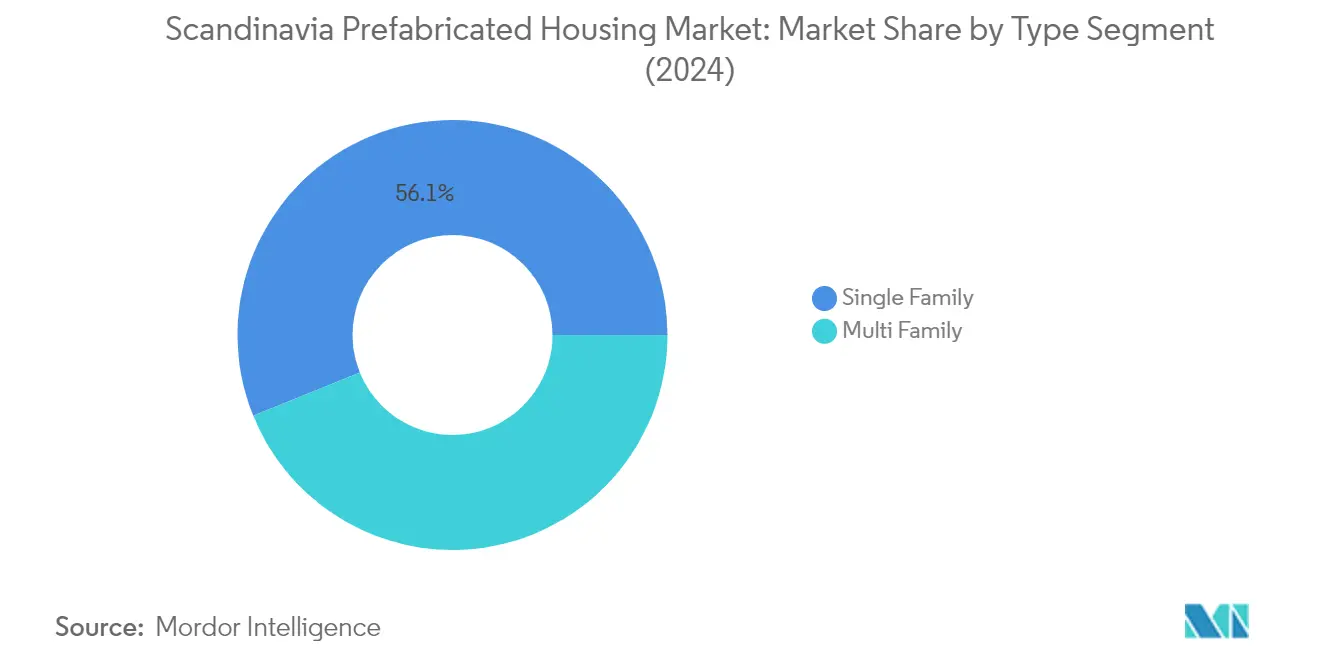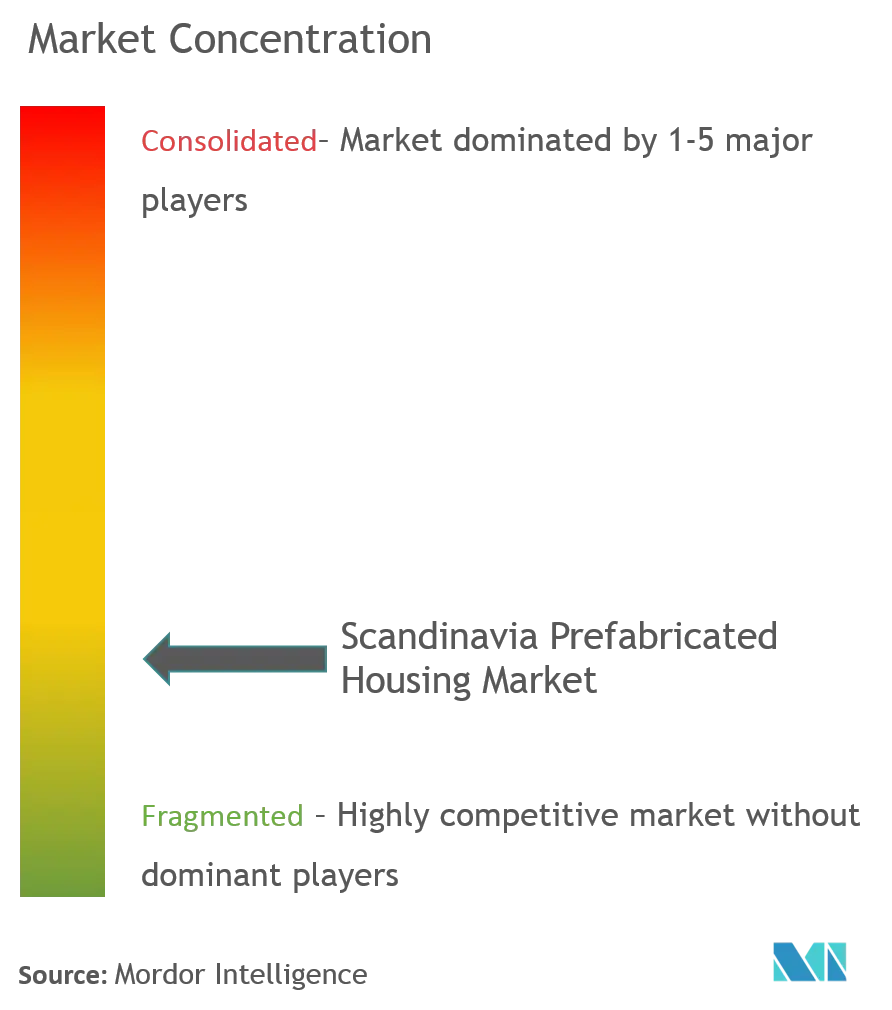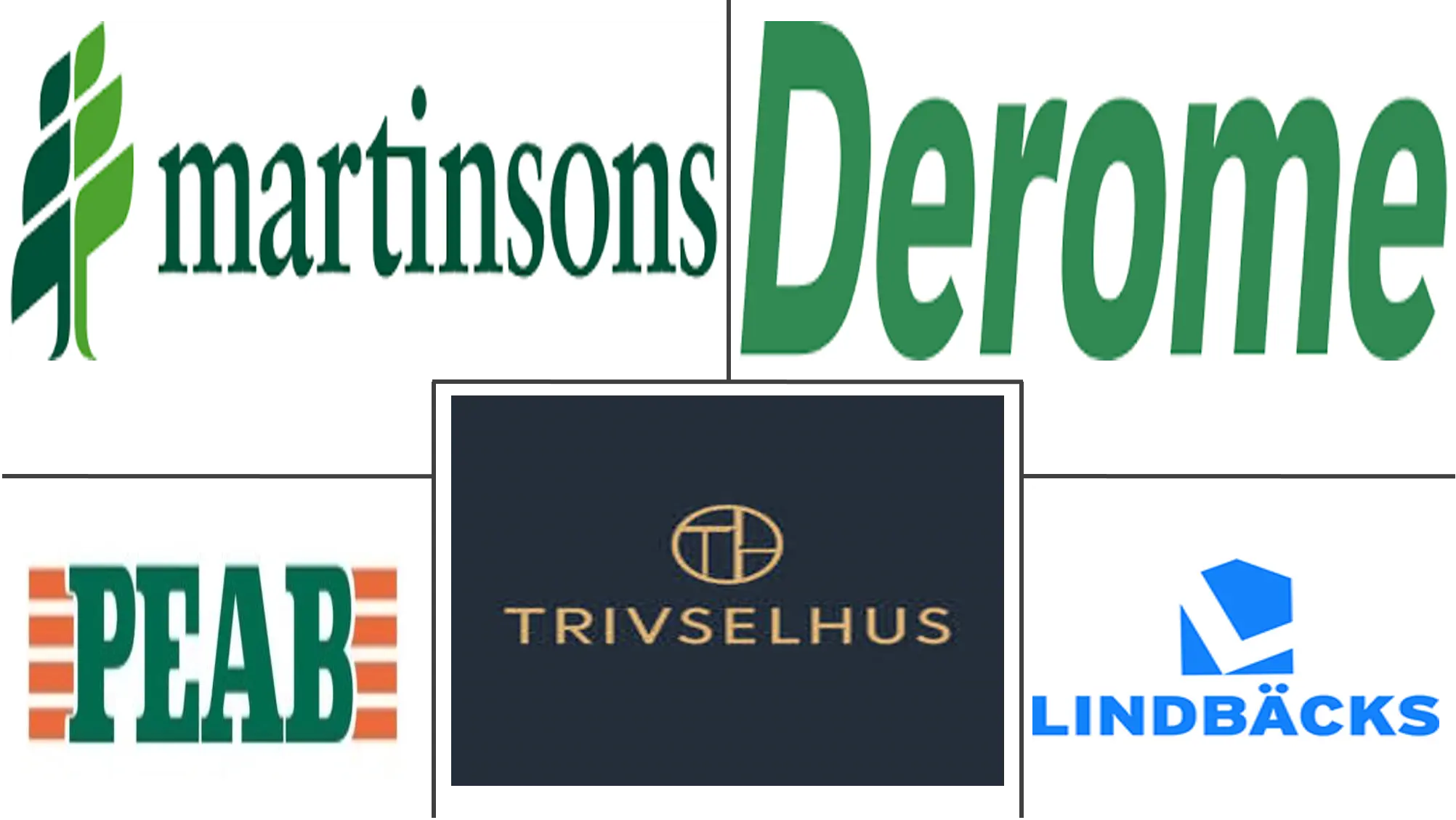Scandinavia Prefabricated Housing Construction Market Size and Share

Scandinavia Prefabricated Housing Construction Market Analysis by Mordor Intelligence
The Scandinavia Prefabricated Housing Construction Market size is estimated at USD 6.07 billion in 2025, and is expected to reach USD 7.59 billion by 2030, at a CAGR of 4.59% during the forecast period (2025-2030). With over 80% of Norway's population now residing in cities and Oslo projected to witness a 30% population surge by 2030, the demand for efficient housing solutions has intensified. This urbanization trend has catalyzed innovation in construction methodologies, particularly in Sweden, where at least 45% of new homes utilize offsite manufacturing techniques. The harsh Nordic climate, with winter temperatures frequently dropping to -20°C, has further accelerated the adoption of prefabricated home methods, allowing for efficient year-round production regardless of weather conditions.
The industry is witnessing a remarkable evolution in sustainable construction practices, particularly in major urban centers. Oslo has emerged as a pioneer in sustainable construction, implementing ambitious plans to achieve zero-emission construction sites by 2025. This initiative is particularly significant given that the construction sector currently accounts for 10% of global greenhouse gas emissions and contributes 38% to global CO2 emissions. The transition to sustainable practices has led to innovations in modular construction techniques, with companies increasingly incorporating eco-friendly materials and energy-efficient designs into their manufacturing processes.
Technological advancement and modular innovation are reshaping the industry landscape, with companies like K-Fastigheter's Prefab division expanding their production capabilities to meet surging demand in western Sweden. The integration of configurable Building Information Modeling (BIM) technology has enabled manufacturers to tailor homes to specific project requirements while maintaining efficiency in production. This technological evolution has facilitated the development of sophisticated projects like BIG's 66-unit affordable housing development in Copenhagen, which showcases the potential of prefabricated housing modules in creating architecturally distinctive and sustainable urban housing solutions.
The market is witnessing a significant shift toward integrated housing solutions that combine affordability with sustainability. Companies like Selvaag Bolig are pioneering large-scale developments, such as the Sandsli 360 project, which demonstrates the scalability of industrialized building systems. The industry's focus has expanded beyond mere construction efficiency to encompass broader environmental and social considerations, including the integration of renewable energy systems and the development of community-oriented spaces. This holistic approach to housing development reflects the growing recognition of manufactured housing as a solution to both environmental challenges and urban housing needs in Scandinavia.
Scandinavia Prefabricated Housing Construction Market Trends and Insights
Rapid Urbanization and Population Growth
The increasing urbanization across Scandinavian countries is creating substantial demand for prefabricated housing solutions. In Norway alone, the urban population has reached a significant milestone, with 71.37% of the total population residing in urban areas and cities as of 2021. This trend is particularly evident in major metropolitan areas like Oslo, which is experiencing one of Europe's fastest growth rates and is projected to see a 30% population surge by 2030. This rapid urban expansion is creating an urgent need for efficient housing solutions that can be deployed quickly to accommodate the growing urban population.
The urbanization trend is driving the need for innovative housing solutions that can address the challenges of limited urban space while maintaining the high living standards characteristic of Scandinavian countries. The pressure on housing infrastructure is particularly intense in capital cities and major urban centers, where the demand for new residential units continues to rise. This is evidenced by Norway's construction sector response, which saw the initiation of 26,118 new building projects in 2021, marking an 11% increase from the previous year, with a further 72% surge in new home construction projects observed in January 2022 compared to the same period in the previous year.
Sustainability and Energy Efficiency Focus
Scandinavian countries' strong commitment to environmental sustainability and energy efficiency is propelling the adoption of modular housing solutions. Swedish housing stands as a testament to this commitment, with prefabricated homes demonstrating remarkable energy efficiency, consuming less than 50% of the energy used by American homes. This significant energy performance advantage is achieved through advanced manufacturing processes and innovative design approaches that prioritize sustainability throughout the construction process.
The integration of sustainable practices in panelized housing construction is further exemplified by Sweden's position as Europe's leading innovator in homebuilding processes and energy performance. The country's success in this area is demonstrated by the fact that 96% of Swedish housing is constructed using an off-site process, which not only ensures better quality control but also minimizes waste and reduces the environmental impact of construction activities. This approach to sustainable construction has established Sweden as a global benchmark, with 84% of Swedish detached homes incorporating prefabricated elements, significantly surpassing the adoption rates in other developed nations such as Japan (15%), and the United States, United Kingdom, and Australia (5% each).
Advanced Manufacturing Capabilities and Innovation
Scandinavia's advanced manufacturing infrastructure and technological expertise have positioned the region as a global leader in manufactured housing production. Sweden, in particular, has emerged as the world leader in prefabricated building systems, with its manufacturers pioneering off-site construction techniques that have achieved success on an unprecedented scale. The region's manufacturing capabilities are particularly evident in the production of wooden houses, with Sweden maintaining the world's highest percentage of factory-built wooden houses, primarily utilizing advanced closed wall panel systems.
The sophisticated manufacturing ecosystem in Scandinavia is supported by continuous innovation in production processes and materials. The region's manufacturers have developed highly efficient modular homes construction techniques that enable the production of high-quality housing components in controlled factory environments. This manufacturing excellence is particularly evident in Sweden, where the prefabricated housing industry has successfully scaled its operations to meet the growing demand for sustainable housing solutions. The industry's focus on innovation extends beyond manufacturing processes to encompass the entire value chain, from design and production to assembly and installation, ensuring optimal efficiency and quality throughout the construction process.
Segment Analysis
Single Family Segment in Scandinavia Prefabricated Housing Market
The single-family homes segment dominates the Scandinavia prefabricated housing market, commanding approximately 56% of the total market share in 2024. This significant market position is driven by several factors, including the increasing preference for standalone modular homes in suburban and rural areas across Sweden, Norway, and Denmark. The segment's growth is particularly strong in Sweden, where at least 45% of new homes are built using offsite manufacturing, with prefab dominating at around 80% of construction methods. The harsh Scandinavian climate, with winter temperatures regularly dropping to -20°C, has been a key catalyst for the rise of single-family prefabricated homes, as they can be manufactured indoors and quickly assembled during viable weather conditions. Additionally, the Swedish government's emphasis on sustainability in construction has further bolstered the adoption of prefabricated single-family homes, as this approach typically reduces carbon emissions by up to 40%.

Multi Family Segment in Scandinavia Prefabricated Housing Market
The multi-family segment is emerging as the fastest-growing segment in the Scandinavia prefabricated housing market, with a projected growth rate of approximately 7% from 2024 to 2029. This accelerated growth is primarily driven by increasing urbanization across Scandinavian countries, particularly in major metropolitan areas like Stockholm, Oslo, and Copenhagen. The segment is witnessing significant innovation in modular construction techniques, enabling faster construction of apartment complexes and multi-dwelling units. The trend is particularly evident in urban development projects that prioritize space efficiency and sustainable living solutions. The growth is further supported by government initiatives promoting affordable housing solutions and the increasing adoption of modern prefabrication technologies in multi-family residential projects. The segment's expansion is also bolstered by the rising demand for energy-efficient and environmentally sustainable housing solutions in urban areas, where multi-family prefabricated buildings offer significant advantages in terms of construction speed and resource optimization.
Geography Analysis
Prefabricated Housing Market in Sweden
Sweden continues to dominate the Scandinavian prefabricated housing landscape, holding approximately 44% of the market share in 2024. The country's harsh climate, with winter temperatures regularly dropping to -20°C, has been a significant catalyst for the rise of offsite construction methods. At least 45% of new homes in Sweden are built using offsite manufacturing, with prefabricated homes commanding an impressive 80% of this segment. The Swedish government's strong emphasis on sustainability in construction has further bolstered the adoption of offsite manufacturing, as this approach typically reduces carbon emissions by up to 40%. The country's prefabricated housing sector benefits from a well-established ecosystem of manufacturers and suppliers, supported by advanced technological infrastructure and innovative construction techniques. Swedish manufacturers have particularly excelled in developing energy-efficient and environmentally sustainable prefabricated homes solutions, aligning with the country's ambitious climate goals. The market has also seen significant innovations in modular construction methods, enabling faster project completion times and reduced on-site construction activities.
Prefabricated Housing Market in Denmark
Denmark's prefabricated housing market is projected to grow at approximately 8% annually from 2024 to 2029, marking it as the fastest-growing market in Scandinavia. The country has emerged as a pioneer in innovative prefabricated homes solutions, particularly in multi-story apartment developments. Danish companies have established a significant edge in the sector by moving beyond traditional container-like designs to offer diverse housing options, including sophisticated multi-story apartment blocks. The market's growth is driven by the country's strong focus on sustainable urban development and the increasing demand for affordable housing solutions. Danish manufacturers have particularly excelled in combining high-quality craftsmanship with modern design aesthetics, creating modular homes that challenge traditional perceptions of modular construction. The sector has also benefited from significant technological advancements in manufacturing processes, enabling greater customization options while maintaining cost efficiency. The country's robust construction regulations and emphasis on energy efficiency have further shaped the development of innovative manufactured housing solutions.
Prefabricated Housing Market in Norway
Norway's prefabricated housing market has established itself as a significant player in the Scandinavian region, driven by the country's increasing urbanization and the growing demand for efficient housing solutions. The urban population in Norway has been steadily rising, with over 80% already residing in cities, and Oslo projected to witness a 30% surge in population by 2030. The country's prefabricated homes sector has particularly benefited from the strong emphasis on sustainability and environmental consciousness in construction practices. Norwegian manufacturers have developed innovative solutions for both urban and remote locations, including modular cabins that can be airlifted to areas without road access. The market has also seen significant developments in renovation projects, with companies manufacturing custom elements including insulation, solar panels, and ventilation systems in factory settings. The sector's growth is further supported by the country's commitment to reducing construction sector emissions, with Oslo aiming for all municipal construction sites to be zero-emission by 2025.
Prefabricated Housing Market in Other Countries
The Scandinavian prefabricated housing market is primarily concentrated in Sweden, Norway, and Denmark, with these three countries representing the entirety of the market covered in this analysis. Each country brings unique strengths and innovations to the sector, contributing to the overall advancement of prefabricated homes solutions in the region. The market benefits from strong cross-border collaboration and knowledge sharing among these nations, leading to continuous improvements in construction techniques and sustainability practices. The region's shared commitment to environmental sustainability and efficient construction methods has created a robust ecosystem for prefabricated housing development. While other Nordic countries like Finland and Iceland have their own prefabricated housing markets, they are not included in this specific market analysis of Scandinavia.
Competitive Landscape
Top Companies in Scandinavia Prefabricated Housing Market
The Scandinavian prefabricated housing market features prominent players like Peab AB, Derome AB, Martinson Group AB, Lindbacks, and Trivselhus AB leading the industry. These companies are driving innovation through advanced manufacturing technologies and sustainable building practices, particularly in modular homes and manufactured homes. The industry is witnessing a significant shift towards digital transformation, with companies investing in cloud-based collaboration tools, virtual reality for design visualization, and predictive analytics for risk management. Strategic expansions are primarily focused on strengthening regional presence through acquisitions and joint ventures, while operational agility is being enhanced through the integration of smart digital technologies and modular construction techniques. Companies are also emphasizing green building solutions and investing in cutting-edge technologies to improve production efficiency and reduce environmental impact.
Fragmented Market with Growing Consolidation Trends
The Scandinavian prefabricated housing market exhibits a moderately fragmented structure, characterized by numerous small and medium-sized enterprises operating alongside established market leaders. The competitive landscape is particularly dynamic in Sweden, which serves as the epicenter of innovation and market development in the region. Market participants are increasingly turning to mergers, acquisitions, and joint ventures, both among themselves and with smaller firms, to gain access to new products, technologies, and market shares. This consolidation trend is driven by the need to achieve economies of scale, enhance technological capabilities, and strengthen market presence across different regions.
The market is witnessing a gradual shift from pure-play manufacturers to integrated solution providers, with companies expanding their service offerings across the value chain. Local players maintain a strong presence due to their understanding of regional building codes and customer preferences, while larger conglomerates leverage their financial strength and technological expertise to capture market share. The industry's competitive dynamics are further shaped by the increasing focus on sustainability and energy efficiency, with companies investing in research and development to meet evolving customer demands and regulatory requirements.
Innovation and Sustainability Drive Future Success
Success in the Scandinavian prefabricated housing market increasingly depends on companies' ability to balance innovation with cost-effectiveness while maintaining high-quality standards. Market leaders are focusing on developing smart manufacturing capabilities, implementing advanced materials, and creating customizable design solutions to differentiate their offerings. The integration of digital technologies, from design to delivery, is becoming crucial for maintaining a competitive advantage. Companies are also investing in sustainable production methods and eco-friendly materials to align with stringent environmental regulations and changing consumer preferences.
For new entrants and smaller players, success lies in identifying and serving niche market segments while building strong local partnerships. The ability to offer flexible financing options, superior after-sales service, and customization capabilities is becoming increasingly important for market success. Companies must also navigate the challenges of transportation costs and logistics, which can significantly impact market reach and profitability. The future competitive landscape will be shaped by players' ability to adapt to changing regulatory requirements, particularly those related to energy efficiency and sustainable construction, while maintaining operational efficiency and customer satisfaction. Furthermore, the adoption of industrialized building systems is expected to play a pivotal role in enhancing construction efficiency and sustainability.
Scandinavia Prefabricated Housing Construction Industry Leaders
Peab AB
Derome AB
Martinson Group AB
Lindbacks
Trivselhus AB
- *Disclaimer: Major Players sorted in no particular order

Recent Industry Developments
- April 2022: Lindbäcks signed an agreement with K-fast, Eskilstuna's municipal properties. The agreement includes 86 rental apartments in three wooden buildings with geothermal heating and solar cells. The choice of Lindbäcks as a building contractor and house in wood will, together with the installation of geothermal heating and solar cells, lead to the housing project in Skogstorp coming down to a lower climate impact in the construction process and low energy consumption for future operation.
- March 2022: Lindbäcks started producing apartments for the project Film for Family Housing. The film in Bandhagen is a project with 35 rental apartments. The film project comprises 35 rental apartments in a house with three stairwell entrances and four floors high. The box camera consists of four houses on seven floors and 148 rental apartments. They follow the design of Stockholmshusen with a plaster façade and will both be built in the Bandhagen district of Stockholm.
Scandinavia Prefabricated Housing Construction Market Report Scope
Prefabricated homes, often referred to as prefab homes are primarily manufactured in advance off-site, then delivered and assembled on site. This report covers market insights, such as market dynamics, drivers, restraints, opportunities, technological innovation, and its impact, porter's five forces analysis, and the impact of COVID-19 on the market. In addition, the report also provides company profiles to understand the competitive landscape of the market.
Scandinavia Prefabricated Housing Market is segmented by Type (Single Family and Multi Family), and by Country (Sweden, Norway, and Denmark).
| Single Family |
| Multi Family |
| Sweden |
| Norway |
| Denmark |
| By Type | Single Family |
| Multi Family | |
| By Country | Sweden |
| Norway | |
| Denmark |
Key Questions Answered in the Report
How big is the Scandinavia Prefabricated Housing Market?
The Scandinavia Prefabricated Housing Market size is expected to reach USD 6.07 billion in 2025 and grow at a CAGR of 4.59% to reach USD 7.59 billion by 2030.
What is the current Scandinavia Prefabricated Housing Market size?
In 2025, the Scandinavia Prefabricated Housing Market size is expected to reach USD 6.07 billion.
Who are the key players in Scandinavia Prefabricated Housing Market?
Peab AB, Derome AB, Martinson Group AB, Lindbacks and Trivselhus AB are the major companies operating in the Scandinavia Prefabricated Housing Market.
What years does this Scandinavia Prefabricated Housing Market cover, and what was the market size in 2024?
In 2024, the Scandinavia Prefabricated Housing Market size was estimated at USD 5.79 billion. The report covers the Scandinavia Prefabricated Housing Market historical market size for years: 2020, 2021, 2022, 2023 and 2024. The report also forecasts the Scandinavia Prefabricated Housing Market size for years: 2025, 2026, 2027, 2028, 2029 and 2030.



